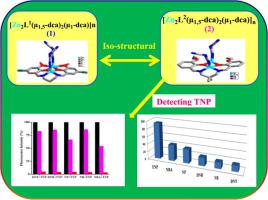Spectrochimica Acta Part A: Molecular and Biomolecular Spectroscopy ( IF 4.4 ) Pub Date : 2021-02-23 , DOI: 10.1016/j.saa.2021.119612 Dhrubajyoti Majumdar , Swapan Dey , Annu Kumari , Tapan Kumar Pal , Kalipada Bankura , Dipankar Mishra

|
Two new dicyanamide bridged multinuclear Zn complexes, [Zn2(L1)(µ1,5-dca)2(µ1-dca)]n (1) and [Zn2(L2)(µ1,5-dca)2(µ1-dca)]n (2) have been synthesized using N2O4-based pro-ligands (H2L1 = N,N′-bis(5-bromo-3-methoxysalicylidenimino)-1,3-diaminopropane, H2L2 = N,N′-bis(3-ethoxysalicylidene)-2,2-dimethyl-1,3-propanediamine) and characterized by microanalytical and spectroscopic techniques. Both complexes are stable in solution and solid-state. Thermogravimetric analysis (TGA) findings showed that complexes are stable at room temperature. Single-crystal X-ray diffraction (SCXRD) has proven that complexes are identical structures where two zinc metal ions are crystallographically independent. The directional properties of dicyanamide co-ligands via µ1,5 bridging have resulted in different connectivity of zinc metal ions leading to 1D templates. SCXRD revealed some notable non-covalent interactions (π⋯π, C-H····π, and H-bonding) in their solid-state crystal structures. 1–2 have strong fluorescence behaviour over pro-ligands, which may be quenched in the presence of various electron-deficient explosive nitroaromatic compounds (epNACs). Complex 2 fluorescence intensity is sharper than 1; hence the former retained high sensitivity and selectivity for trinitrophenol (TNP). The enhancement of fluorescence mechanism, detection limit (LOD), and the quenching constant (KSV) have been calculated using the Stern-Volmer equation (SV), where the KSV value for TNP is found to be 1.542 × 104 M−1. The solution phase quenching mechanism has been rationalized by (a) electrostatic interactions through charge-transfer complex, (b) photo-induced electron transfer (PET) by the HOMO-LUMO energy gap via DFT, and (c) fluorescence resonance energy transfer (FRET). Finally, complex 2 is applied as a sensor by turn-off fluorescence response to detecting TNP nitroaromatics in the DMF medium.
中文翻译:

基于N 2 O 4型前配体的两种新型锌配合物的双氰胺交织组装:合成,晶体网络,光谱学见解和选择性硝基芳族截止荧光传感
两个新的双氰胺桥连的多核Zn络合物,[Zn 2(L 1)(µ 1,5 -dca)2(µ 1 -dca)] n(1)和[Zn 2(L 2)(µ 1,5 -dca) )2(µ 1 -dca)] n(2)已使用基于N 2 O 4的原配体(H 2 L 1 = N,N'-双(5-溴-3-甲氧基水杨酰亚氨基)-1合成, 3-二氨基丙烷,H 2 L 2 = N,N′-双(3-乙氧基水杨基)-2,2-二甲基-1,3-丙二胺,并通过显微分析和光谱技术表征。两种络合物在溶液和固态下均稳定。热重分析(TGA)结果表明,配合物在室温下稳定。单晶X射线衍射(SCXRD)已证明,配合物是相同的结构,其中两个锌金属离子在晶体学上是独立的。通过µ 1,5桥联反应获得的双氰胺共配体的方向性导致锌金属离子的连通性不同,从而形成一维模板。SCXRD揭示了它们固态晶体结构中一些值得注意的非共价相互作用(π⋯π,CH···π和H键)。1 – 2具有比原配体强的荧光行为,可在存在各种电子缺陷的爆炸性硝基芳香族化合物(epNAC)的情况下淬灭。配合物2的荧光强度大于1 ; 因此,前者保留了对三硝基苯酚(TNP)的高灵敏度和选择性。的荧光机构,检测限(LOD)和淬灭常数(K增强SV)用Stern-Volmer方程(SV),其中K个已计算SV为TNP值被发现为1.542×10 4中号- 1个。通过(a)通过电荷转移络合物的静电相互作用,(b)通过DFT的HOMO-LUMO能隙通过光致电子转移(PET)和(c)荧光共振能量转移(烦恼)。最后,通过关闭荧光响应来检测DMF介质中的TNP硝基芳烃,将络合物2用作传感器。


























 京公网安备 11010802027423号
京公网安备 11010802027423号